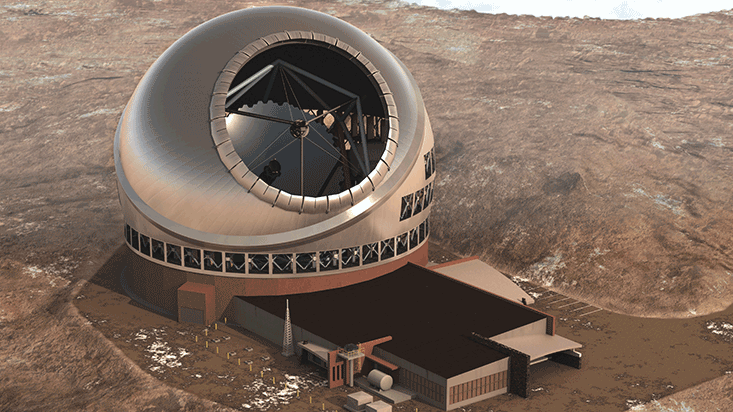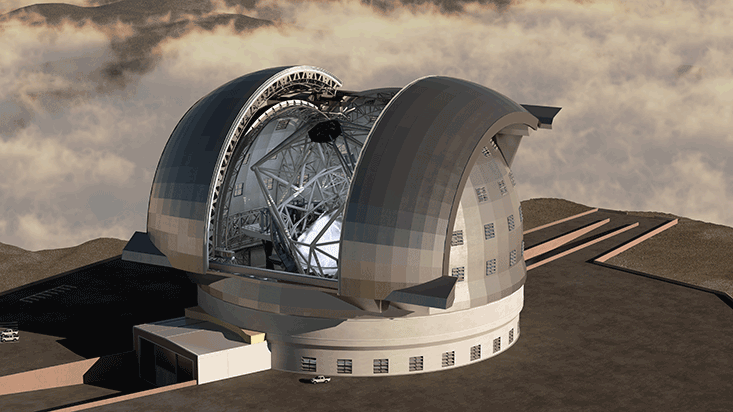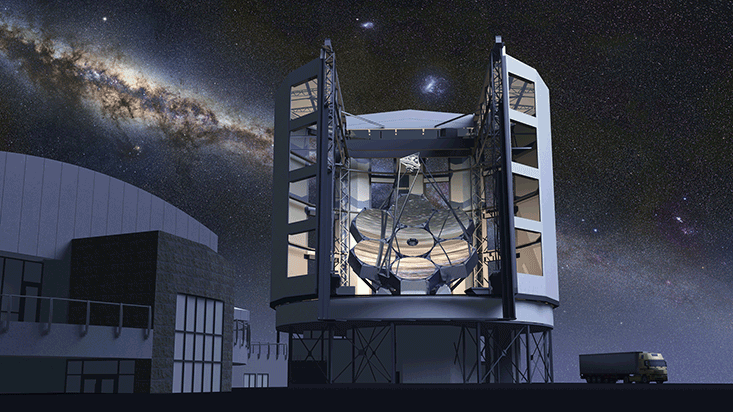When Warner Brothers animators wanted to include cutting-edge astronomy in a 1952 Bugs Bunny cartoon1 they set a scene at an observatory that looks like Palomar Observatory in California. The then-newly unveiled Hale Telescope, stationed at Palomar, had a 5-meter-diameter mirror, the world’s largest. In 1989, when cartoonist Bill Watterson included a mention of the world’s largest telescope in a “Calvin and Hobbes” cartoon,2 he again set the action at Palomar. Although computers had grown a million times faster during those 38 years, and eight different particle colliders had been built and competed for their field’s top ranking, astronomy’s king of the hill stayed perched on its throne.
This changed in 1992, with the introduction of the Keck telescope and its compound, 10-meter mirror. About a dozen 8-10 meter telescopes have been built since. But it has been more than 20 years since this last quantum leap in telescope technology. Now, finally, the next generation is coming. Three telescopes are on their way, and the race among them has already begun.
Three new observatories are on the drawing boards, all with diameters, or apertures,3 between 25 and 40 meters, and all with estimated first light being collected in 2022: the Giant Magellan Telescope (GMT, headquartered in Pasadena, Calif.), the Thirty Meter Telescope (TMT, also in Pasadena) and the European Extremely Large Telescope (E-ELT, headquartered in Garching, Germany). At stake are the mapping of asteroids, dwarf planets, and planetary moons in our solar system; imaging whole planetary systems; observing close-in the Goliathan black hole at the Milky Way’s core; discovering the detailed laws governing star and galaxy formation; and taking baby pictures of the farthest objects in the early universe.
Thanks to these telescopes, astronomy is poised to reinvent itself over the next few decades. Renown and glory, headlines and prestige, and perhaps a few Nobel Prizes too, will go to those astronomers that first reveal a bit of new cosmic machinery. Surprisingly, the story of this race will be written, not just in the technical specifications and design breakthroughs of the instruments themselves, but also in the organizational approaches that each team has taken. The horse race is a unique window both into technology, and into the process of science itself.

In the 50 years following its 1949 construction, the telescope that came closest to beating the performance of the Palomar Observatory was the Bolshoi Teleskop Alt-azimutalnyi (BTA-6), a Soviet telescope that used a 6-meter mirror and was christened in 1975. But the BTA-6 only proved how difficult it is to build and operate single-mirror telescopes larger than 5 meters. Its mirror was so elephantine that it cracked under its own weight, and the heat from the light it collected destabilized its sensitive optics. As a result, for productive astronomical observatories, Palomar remained the world’s most powerful until 1992, when the 10-meter W.M. Keck Observatory telescope in Hawaii first opened its eyes.
Keck’s history began with a single American physicist called Jerry Nelson, an upstart scientist at the Lawrence Berkeley National Laboratory. In 1977, conventional wisdom held that a 10-meter instrument, just as subject to gravity’s warp as BTA-6, was extremely impractical if not downright impossible. Nelson’s innovation was not to rely on one mirror but rather on a honeycomb-like structure of small, hexagonal mirror segments. Each flexible and lightweight mirror would be independently mounted and had its own curvature unique to its placement in the array. A mirror in the center would be curved upward on all six sides. A mirror placed off-axis to the right would curve down on its left edges and up on its right. The sum total structure of hexagonal mirrors would be a meta-mirror that behaved exactly like a curved single mirror.
Nelson’s design was made more complex by the fact that as the telescope’s body rotated, each mirror needed to be adjusted on the fly by arrays of computerized screws and flywheels that nudged the mirrors so as to compensate for gravity’s pull.
Its mirror was so elephantine that it cracked under its own weight.
“I remember when Jerry Nelson used to give these talks,” says Michael Bolte, TMT member and astronomy professor at the University of California, Santa Cruz. “Everybody thought he was completely nuts. They thought, if you get out in the real world where the wind blows and gravity vectors change and humidity changes, surely this would never work.” Even today, astronomers’ skepticism seems well warranted. To operate a 10-meter telescope using Nelson’s design required continual monitoring and adjustment of each mirror segment’s position to within a few billionths of a meter.
On top of that, Keck later implemented the further innovation of using another array of computers to monitor minute disturbances in the atmosphere above the telescope. Then an additional, deformable mirror down the line could compensate for the tiny thermal wiggles that the atmosphere introduces to a star’s image.
In other words, Nelson hoped to design a telescope that could “subtract” off the influence of the earth’s atmosphere, all but launching his instrument into space without ever lifting it off the ground. (Such adaptive optics are being used in all three next-generation telescope projects.)
No wonder, then, that many leading astronomers in the 1980s and early 1990s had written off Nelson’s scheme. A 1993 Los Angeles Times profile of Nelson, for instance, quotes an anonymous source it describes as “one of the nation’s top telescope designers.” The anonymous source rated Nelson an “arrogant fool” and predicted that the W.M. Keck Observatory’s $200 million price tag would ultimately just be money down the drain.
Yet when in 1992 the Keck telescope—followed by its cousin Keck II in 1996—instead delivered on its designers’ promise of ushering in a new era of 10-meter class astronomy, other observatories around the world were caught by surprise.
“These problems you’d been working on your whole career, after one night on Keck, you’d have all the data you’d need,” Bolte says. “We were actually unpopular with much of the world. And there were many people who, when we started thinking about a 30-meter telescope, swore they’d never get ‘Keck’ed again.”
The history of the Keck design continues to color the field. One of the three teams, TMT, has directly inherited Keck’s design and many of its team members, including Nelson. TMT will also share mountaintop space with Keck, on the dormant Mauna Kea volcano in Hawaii. Its new design is an extension of Keck’s segmented hexagonal mirror to the 30-meter scale. TMT’s Bolte adds, with not more than the tiniest amount of relish, that the competing E-ELT team developed a similar plan to the TMT/Keck’s, even without any legacy or institutional inertia pushing it toward one telescope design or another.
“I don’t want to sound like I’m criticizing anybody here,” he says. “But I think if you were really going to design a telescope from scratch, a 25 to 30 meter telescope, you’d almost certainly pick the TMT design over the GMT design. That is, small segments with very tiny gaps. As evidence for that, the Europeans could have done whatever they wanted. They had a clean slate… They did the cost benefit analysis and concluded that a telescope very much like the TMT was the way to build.”
In fact, TMT and E-ELT’s mirror segments are exactly the same size scale, 1.44 meters. (They’re not interchangeable, though, as each mirror has a different curve and warp.) Asked why his team picked the same mirror component size as TMT, Tim de Zeeuw, director general of the European Southern Observatory (ESO), noted that “there is … no formal intention to collaborate on the production of segments, but since the sizes are the same it is however also not impossible.” The TMT will use its 492 hexagonal mirrors to create an effective 30-meter aperture. E-ELT, to be sited on a mountaintop observatory in the Atacama Desert near Antofagasta, Chile, will use 798 hexagonal mirror segments to create an effective telescope size of 39 meters.

The GMT telescope, by contrast, uses seven circular 8.4-meter mirrors that all reflect into a central convex mirror suspended above the primary mirror. The seven-mirror structure, to be situated on a mountaintop observatory near La Serena, Chile, together create a meta-mirror with a resolving power equivalent to that of a 24.5 meter single-mirror telescope. The segments (of which one has been completed and two more are being manufactured) use a lightweight honeycomb design that overcomes the 6-meter limit that BTA-6 famously encountered. The University of Arizona, a GMT partner institution, is making the mirrors in its Steward Observatory Mirror Lab, located beneath the university’s football stadium.
“Completing the first mirror segment was a very significant milestone for us,” says Charles Alcock, director of the Harvard-Smithsonian Center for Astrophysics and member of the GMT board. “It has a very complicated shape, since it’s an off-axis segment it’s not symmetrical about its center. And it’s being polished to an accuracy of 19 nanometers. So it is the best large optical surface ever created in human history.”
Roger Angel,1 professor of astronomy and optics at the University of Arizona, was the GMT’s chief architect and intellectual forebear. Alcock notes that although Keck was the first 10-meter class telescope, there are other telescopes—including the Magellan Telescopes in Chile (distinct from the Giant Magellan Telescope) and the Multiple Mirror Telescope and Large Binocular Telescope in Arizona—that do not use the Keck design. “The TMT is a direct successor to the Kecks, but with 492 segments, up from 36, it is a significantly different design,” Alcock says. “The GMT design … has as much heritage as—arguably more than—the TMT design.”

With so much hard science in the balance, one might think that the varying designs of the three competing telescopes would decide which is first past the post. But there is a more prosaic aspect to the competition: Securing partners. This boils down to a kind of musical chairs of international corporations, institutes, and national organizations. “Everybody in our world knows who the potential partners are,” says Alcock. “If we’re talking with somebody, you just know that TMT has probably had some contact with them. I think it’s unlikely that any individual potential partner would join both projects. It’s high stakes in that regard.”
“The GMT realized very early on that they needed to find some more partners to fund their telescope, so we were all running around the world doing the same thing,” says TMT’s Bolte. “We’d show up at the airport in Beijing just as somebody from the E-ELT was leaving. Or we’d run into [GMT leader] Wendy Friedman in the airport in Tokyo. We were all talking up our projects to all of these countries. I don’t know for sure how they made their choices. But I’m really pleased that we got some of the major players to select our project given the choice of all three.”
A major win for TMT was China, a country whose economic size and scientific stature meant that each telescope’s officials watched its courtship maneuvers closely. China had considered making its own 30-meter class telescope, but the country doesn’t have mountaintop sites that boast the astronomically perfect conditions of the dry Chilean mountains or the Mauna Kea summit. Shude Mao of the Chinese National Astronomical Observatories in Beijing now sits on the TMT board. He says Keck’s impressive track record was an important factor in swaying the world’s second-largest economy toward TMT.
The anonymous source rated Nelson an “arrogant fool” and predicted that the W.M. Keck Observatory’s $200 million price tag would ultimately just be money down the drain.
China’s decision also reveals the different kinds of organizational structures at play in each of the three competing teams. The E-ELT has a European model of national-level cooperation. Joining the E-ELT requires membership in the ESO and a pledge of a small fixed percentage of a country’s gross domestic product (GDP) toward the ESO budget. This would have made membership expensive for China, whose GDP in 2013 was $9 trillion.
Both GMT and TMT have a trim and more corporate American-style organization that is part institutional, part national partnerships. GMT was less attractive to China, however, because it mandates cash contributions. By contrast, Mao says, 70 percent of China’s contribution to TMT in its earliest stages can be “in kind.” This means China may be required to manufacture and then donate a spectrometer or a certain number of the TMT’s 492 mirror segments. But China could then also do this work in-country, stimulating its own industries. “That is extremely important to us,” Mao says.
By contrast, says Brian Schmidt of the Australian National University, GMT downplays in kind contributions for a good reason. Schmidt, a Nobel Laureate astronomer and a leader in GMT’s effort to sign on Australia, explains that GMT awards its contracts only on the basis of scientific and technical merit. It plays no favorites in awarding its work orders. “It’s a real minimalist structure that’s focused on really getting the thing done,” Schmidt says of the GMT organization.
Other big countrywide “gets” round out the early tally. As of early 2014, these have been Brazil signing on to ESO (and thus E-ELT), although this still requires ratification by the Brazilian Parliament; South Korea and Australia putting their weight behind GMT; and China, India, and Japan backing TMT.
The resulting three-way race, as ESO public information officer Richard Hook describes it, is a kind of portmanteau of cooperation and competition. “You could call the situation ‘Co-opetition,’ ” he says.
For each of the three telescope projects, much of the industrial work and projected completion dates are well-guarded trade secrets. All three telescopes’ websites leave the exact projected date of their completion unknown, expressing the likelihood that each will be completed and conducting actual science by 2022. But each community clearly has a common goal in mind: to be first.
“I’m really hoping we’re still going to be first,” Bolte says of TMT. “We would have liked to have started building this telescope five years ago. I think technically we were ready to do that. What we didn’t have is our partnerships put together.”
Says ESO’s Hook of his group’s E-ELT, “Yes, the scientific community that we serve is of course keen to be first.” But he goes on to add, “It is certainly possible to overstate the level of competition. All three will be general-purpose telescopes with long lives. They are not focused on one result.”
In fact, every official from the three telescopes that Nautilus spoke to for this story was careful to couch their assessments of the competition in collegial terms. More than once it was expressed that they didn’t want to appear sniping or derogatory toward telescopes that, in all likelihood, will be as much collaborators as rivals. No one seemed to want to provide justifiable cause for bad blood. But that each team is also in a race to the finish was plainly obvious.
Regardless of the winner among the three teams, should all three telescopes be built—and no expert consulted for this story predicted any other outcome—they will likely surge astronomy ahead unlike any time in modern memory. The only precedent within the professional lifetimes of astronomers working today would be Keck’s launch in 1993. Just what new windows on the universe this trio of extraordinary scientific instruments may open remains anyone’s guess.
“Our experience with previous generations of telescopes is that people do carry out the science programs that led them to build the telescopes,” says Alcock. “But frequently the most exciting science is something that nobody was thinking about. Something entirely unanticipated.”
Mark Anderson is a science and technology journalist who has written for Discover, Technology Review, Scientific American, Science, Wired, IEEE Spectrum, New Scientist, and Rolling Stone.
Footnotes
1. The last scene of this 1952 Bugs Bunny cartoon featured an observatory that looked a suspicious amount like the Palomar Observatory in California.
2. In this 1989 comic, Calvin, disguised as “Stupendous Man,” visits Palomar Observatory.
3. For more information on the lenses used in telescopes, visit Starizonia.






























